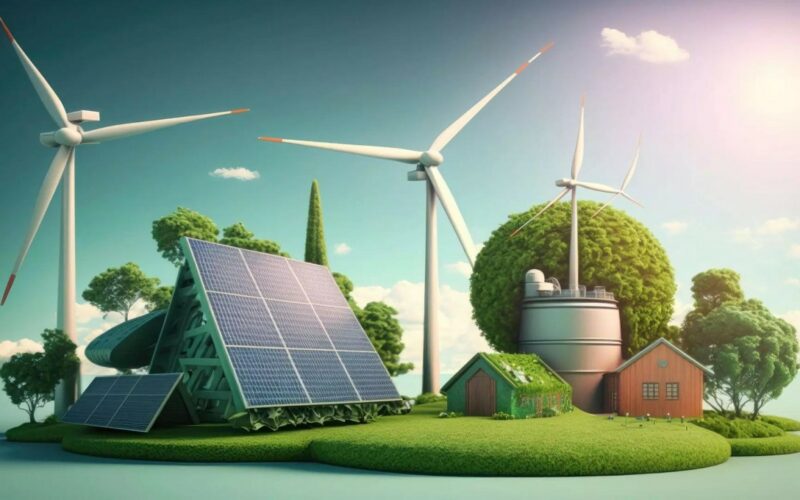By Khadija Bello Liman
As urban growth rapidly increases globally, the demand for energy in cities has also increased, therefore posing significant challenges to sustainability and environmental health and growth. Renewable energy is derived from natural resources that are replaced at a faster rate than they are consumed, it presents a valid solution to these challenges. If there is high demand for energy, then renewable energy provides a plausible solution to this problem
However, renewable energy refers to energy sources that are naturally replaced and can be regenerated over a short period of time therefore it is always in abundance, unlike fossil fuels which can take millions of years to form and regenerate but end up being exhausted in a short period of time, renewable energy come from sources that are abundant and sustainable.
Renewable energy is expected to be one of the fastest-growing sources of future world energy, with consumption increasing by 2.6 per cent per year. The reasons for this are: anticipated increase in oil prices, concern about the environmental effect of fossil fuel use, many scientists worry that the use of fossil fuels is resulting in air pollution and an increased rate of global warming.
Five major geothermal power stations exist in Iceland; 24 per cent of the country’s electricity is produced from geothermal energy 75 per cent from hydroelectric and 1 per cent from fossil fuels. Plans are under way to turn Iceland into a 100% fossil fuel free nation in the near future. Common examples of this include:
Solar energy captured from sunlight, using solar panels (photovoltaic cells). When more solar energy is generated than being used, it can be stored in a battery, wind energy also that generates from wind through turbines, hydroelectric energy produced by harnessing the energy from flowing water, biomass on the other hand is a component of organic materials that can be converted into energy and geothermal energy which is gotten from heat stored beneath the earth surface. It includes fuels like ethanol, biodiesel etc.
For instance, now all over the world in both developed and developing countries we find solar panels (photovoltaic cells) on the roofs of almost every building or house, because they provide a more sufficient solutions to energy supply related problems, they are even used to power electrical inverters, like when there is power or electricity outage the sunlight trapped by these panels are converted into electrical energy to power household appliances or even industrial machineries.
However, energy consumption depends on the economy-both of individual countries and of the whole world. Between the years 2000 and 2007, world energy consumption increased by about 5 per cent a year, as the global economy grew. But then the energy consumption decreased by 2.2 per cent in 2009.However the US Energy information administration has predicted that world energy consumption will increase by about 28 per cent between now and 2040.
China and to a lesser extent India and other Asian countries consume coal instead of more expensive fuels like oil. Coal was used to generate 42 per cent of the world electricity in 2007.But no it has been reported that even they are shifting towards the use of renewable energy instead of relying on coal and other non-renewable energy because of their negative effect on the environment
Furthermore, renewable energy is essential for powering green buildings and infrastructure, for electrifying public transport like modern speed trains and many more modern transport systems, also for enhancing energy efficiency, or supporting smart grid development and it is also a much cheaper alternative to spending millions on electricity alone and electricity makes daily household tasks easier. People do not have to collect fuel or use candles or lamps at night and so much more. Industries also require energy to make it work, without it the economy cannot grow, wealth cannot be increased and people’s lives will not be improved.
For instance, on 22 April 2010, an explosion occurred on the Deep-water Horizon oil rig in the Gulf of Mexico. The rig sank and 11 workers were killed. crude oil up to 5000 barrels began leaking from the damaged oil well on the seabed (1524m down). After the occurrence of this incident many countries decided to engage in the use of more environmentally friendly energy types (renewable energy)
Therefore, incorporating renewable energy into urban development enhances energy security and reliance. Cities can use different energy sources by developing solar panels, wind turbines and solar energy-efficient technologies into infrastructure, thereby reducing heavy reliance on power systems and providing a cheaper alternative to paying power supply companies large amounts of money for 24-hour supply. For instance, smart grids allow better management of energy therefore making it easier to incorporate balanced energy supply and demand without stress.
Nevertheless, renewable energy plays a crucial role in promoting sustainable urban development by reducing emissions, enhancing energy supply and increasing local economic growth, it also provides a pathway towards healthier and more powered cities. Therefore, as urbanization continues to rise, integrating renewable energy into urban growth and development will be essential in creating sustainable environments for future generations. By embracing these technologies, not only are we solving current energy problems, but also lays a structure for sustainable urban future and growth.
Khadija is of Lead British International School, Abuja





